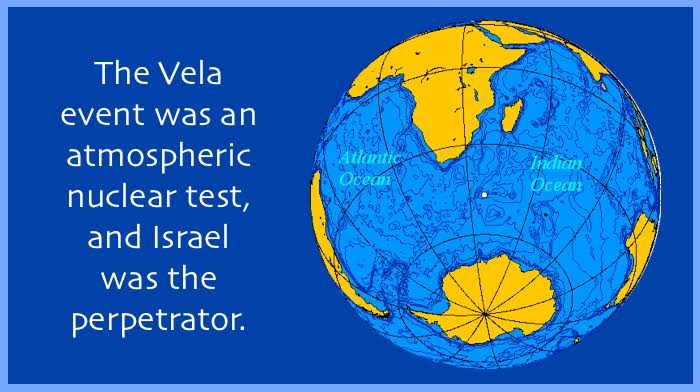On September 22, 1979, a US Vela satellite, designed to detect clandestine nuclear tests, recorded a "flash" off the coast of South Africa that every nuclear scientist monitoring the satellite's detectors at the time believed fit the classic description of a nuclear explosion. President Jimmy Carter's book based on his White House diaries notes that he was immediately informed of the "flash" by his national security team; with the information came speculation that the event was an Israeli nuclear test at sea, with South African participation.
Corroborative data from different sources was immediately sought and analyzed, but much of that data and analysis has remained classified to date (nearly 40 years later), despite attempts to get the government to remove the classification. Independent scientific studies of the event have reinforced the growing circumstantial evidence that the Vela event was an atmospheric nuclear test, and that Israel was the perpetrator, with possible assistance from apartheid South Africa's navy. The US government's position, held to this day, was to neither admit nor deny that a test took place. A panel of scientists carefully selected by the Carter White House produced a report in 1980 that did not rule out a test, but said the probability of its being something other than a test was more likely. That conclusion is now derided by nearly all independent observers who have studied and reported on the issue.
Important new and dispositive evidence that the "flash" was a nuclear test has been added recently by two respected scientists, Christopher Wright of the Australian Defense Force Academy and Lars-Eric De Geer of the Swedish Defense Research Agency (Ret.), writing in the journal Science & Global Security. (The 22 September 1979 Vela Incident: The Detected Double-Flash, Science & Global Security, 25:3, 95-124, DOI: 10.1080/08929882.2017.1394047)
Using data first gathered by Distinguished Professor Lester Van Middlesworth of the University of Tennessee on radioactivity found in the thyroids of sheep in Australia within the time period following the "flash," plus meteorological data from the time and some radionuclide and hydro-acoustic data released by the US government, Wright and De Geer have produced an analysis of the Vela event that removes virtually all doubt that the "flash" was a nuclear explosion. The explosion was one of small yield, perhaps to simulate the result of firing a nuclear artillery shell. Wright and De Geer do not speculate on who might have performed the test. But none of the five recognized nuclear weapon states would feel the need to perform a small clandestine test of that kind. Similarly, in 1979, neither India nor Pakistan nor South Africa had nuclear development and logistics capabilities at a stage where a nuclear test of that kind in that area was feasible for them. Israel was the only country that had the technical ability and policy motivation to carry out such a clandestine test, which, according to some sources, was the last of several and was detected by the Vela satellite because of a sudden change in cloud cover.
The new study by Wright and De Geer should receive wide attention because it provides a test of the commitment by the international community to nuclear arms control and nonproliferation norms. While a comprehensive nuclear test ban is yet to be achieved, the nations of the world did manage to put in place an extremely important arms control, non-proliferation, and environmental protection measure called The Limited Test Ban Treaty (LTBT). This treaty, which went into force in 1963, bans nuclear explosions in the atmosphere, in outer space, and under water, thus rendering legal only those nuclear tests performed underground. Israel signed the treaty in 1963 and ratified it in 1964. The Israeli nuclear test puts Israel in violation of the LTBT, which has been signed by 108 countries, including all the officially recognized nuclear weapon states plus India, Pakistan, and Iran. Israel would also be in violation of the Glenn Amendment to the Arms Export Control Act, a US law passed in 1977, requiring the cutoff of military assistance to any country setting off a nuclear explosion. The president can waive the sanction, but he has to face the issue.
In the meantime, what should be a consequence of the flagrant violation of the Limited Test Ban Treaty?
At a time when public demands for nuclear transparency are loudly and justifiably trumpeted toward Iran and North Korea, which are pariahs in many Western eyes, it is illogical at best and hypocritical at worst for the world, and particularly the United States, to maintain public silence on Israel's nuclear program, especially in the face of a violation of an important nuclear norm. For the sake of future progress on arms control, on steps to reduce nuclear risk, and on honest public as well as private communication among governments and their constituents to achieve such progress, it is time to end an existing double standard that has allowed Israel to escape accountability for developing advanced nuclear weapons by violating a major international treaty.
About Leonard Weiss:.
Leonard Weiss is a visiting scholar at Stanford University's Center for International Security and Cooperation and a member of the National Advisory Board of the Center for Arms Control and Nonproliferation in Washington, DC. For more than 20 years, he worked in the US Senate as Sen. John Glenn's staff director on the Governmental Affairs Committee, writing legislation and leading investigations in the areas of nuclear proliferation and nuclear safety. He was the lead Senate staffer on the Nuclear Nonproliferation Act of 1978 and the Glenn Amendment to the Foreign Assistance Act of 1961. He is a former tenured professor of applied mathematics and engineering at Brown University and the University of Maryland.




Just sayin....